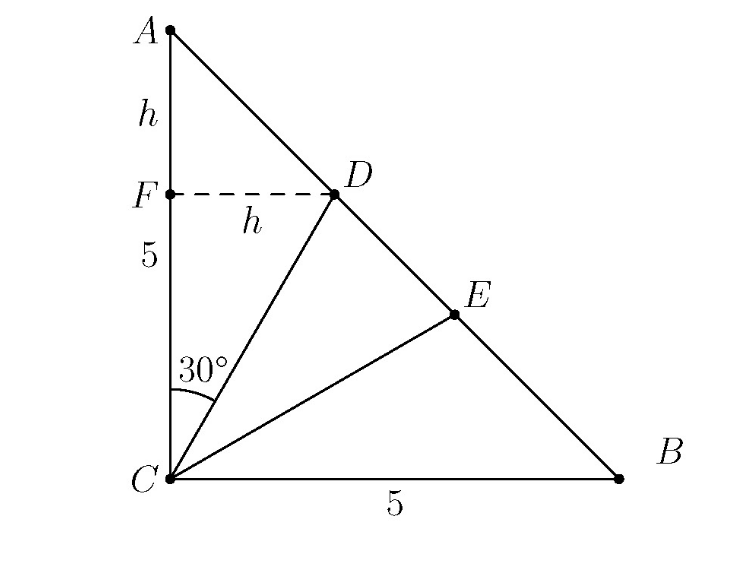2015 AMC 10A Problems/Problem 19
Contents
Problem
The isosceles right triangle ![]() has right angle at
has right angle at ![]() and area
and area ![]() . The rays trisecting
. The rays trisecting ![]() intersect
intersect ![]() at
at ![]() and
and ![]() . What is the area of
. What is the area of ![]() ?
?
![]()
Solution 1 (No Trigonometry)
![]() can be split into a
can be split into a ![]() right triangle and a
right triangle and a ![]() right triangle by dropping a perpendicular from
right triangle by dropping a perpendicular from ![]() to side
to side ![]() . Let
. Let ![]() be where that perpendicular intersects
be where that perpendicular intersects ![]() .
.
Because the side lengths of a ![]() right triangle are in ratio
right triangle are in ratio ![]() ,
, ![]() .
.
Because the side lengths of a ![]() right triangle are in ratio
right triangle are in ratio ![]() and
and ![]() ,
, ![]() .
.
Setting the two equations for ![]() equal to each other,
equal to each other, ![]() .
.
Solving gives ![]() .
.
The area of ![]() .
.
![]() is congruent to
is congruent to ![]() , so their areas are equal.
, so their areas are equal.
A triangle's area can be written as the sum of the figures that make it up, so ![]() .
.
![]() .
.
Solving gives ![]() , so the answer is
, so the answer is 
~Diagram uploaded by mathboy282
Note
Another way to get ![]() is that you assume
is that you assume ![]() to be equal to
to be equal to ![]() , as previously mentioned, and
, as previously mentioned, and ![]() is equal to
is equal to ![]() .
. ![]()
Solution 2 (Trigonometry)
The area of ![]() is
is ![]() , and so the leg length of
, and so the leg length of ![]()
![]() is
is ![]() Thus, the altitude to hypotenuse
Thus, the altitude to hypotenuse ![]() ,
, ![]() , has length
, has length ![]() by
by ![]() right triangles. Now, it is clear that
right triangles. Now, it is clear that ![]() , and so by the Exterior Angle Theorem,
, and so by the Exterior Angle Theorem, ![]() is an isosceles
is an isosceles ![]() triangle. Thus,
triangle. Thus, ![]() by the Half-Angle formula, and so the area of
by the Half-Angle formula, and so the area of ![]() is
is ![]() . The answer is thus
. The answer is thus 
Solution 3 (Analytical Geometry)
Because the area of triangle ![]() is
is ![]() , and the triangle is right and isosceles, we can quickly see that the leg length of the triangle
, and the triangle is right and isosceles, we can quickly see that the leg length of the triangle ![]() is 5. If we put the triangle on the coordinate plane, with vertex
is 5. If we put the triangle on the coordinate plane, with vertex ![]() at the origin, and the hypotenuse in the first quadrant, we can use slope-intercept form and tangents to get three lines that intersect at the origin,
at the origin, and the hypotenuse in the first quadrant, we can use slope-intercept form and tangents to get three lines that intersect at the origin, ![]() , and
, and ![]() . Then, you can use the distance formula to get the length of
. Then, you can use the distance formula to get the length of ![]() . The height is just
. The height is just ![]() , so the area is just
, so the area is just 
Solution 4 (Trigonometry)
Just like with Solution 1, we drop a perpendicular from ![]() onto
onto ![]() , splitting it into a
, splitting it into a ![]() -
-![]() -
-![]() triangle and a
triangle and a ![]() -
-![]() -
-![]() triangle. We find that
triangle. We find that ![]() .
.
Now, since ![]() by ASA,
by ASA, ![]() . Since,
. Since, ![]() ,
, ![]() . By the sine area formula,
. By the sine area formula, ![]()
See Also
Video Solution:
https://www.youtube.com/watch?v=JWMIsCS0Ksk
| 2015 AMC 10A (Problems • Answer Key • Resources) | ||
| Preceded by Problem 18 |
Followed by Problem 20 | |
| 1 • 2 • 3 • 4 • 5 • 6 • 7 • 8 • 9 • 10 • 11 • 12 • 13 • 14 • 15 • 16 • 17 • 18 • 19 • 20 • 21 • 22 • 23 • 24 • 25 | ||
| All AMC 10 Problems and Solutions | ||
The problems on this page are copyrighted by the Mathematical Association of America's American Mathematics Competitions. 










